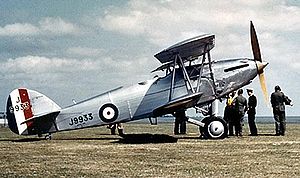Hawker Audax
| Hart | |
|---|---|
 |
|
| Hawker Hart G-ABMR | |
| Role | Light bomber |
| Manufacturer | Hawker Aircraft Limited |
| Designer | Sydney Camm |
| First flight | June 1928 |
| Introduction | 1930 |
| Primary user | Royal Air Force |
| Variants |
Hawker Hind Hawker Hector |
The Hawker Hart was a British two-seater biplane light bomber aircraft of the Royal Air Force (RAF). It was designed during the 1920s by Sydney Camm and manufactured by Hawker Aircraft. The Hart was a prominent British aircraft in the inter-war period, but was obsolete and already side-lined for newer monoplane aircraft designs by the start of the Second World War, playing only minor roles in the conflict before being retired.
Several major variants of the Hart were developed, including a navalised version for the Royal Navy's aircraft carriers. Beyond Britain, the Hart would be operated by a number of foreign nations, including Sweden, Yugoslavia, Estonia, South Africa, and Canada.
In 1926, the Air Ministry stated a requirement for a two-seat high-performance light day-bomber, to be of all-metal construction and with a maximum speed of 160 mph (258 km/h). Designs were tendered by Hawker, Avro and de Havilland.Fairey, who had sold a squadron's worth of its wooden Fox bomber in 1925, was not at first invited to tender to the specification, and was sent a copy of the specification only after protesting to the Chief of the Air Staff, Hugh Trenchard.
Hawker's design was a single-bay biplane powered by a Rolls-Royce F.XI water-cooled V12 engine (the engine that later became known as the Rolls-Royce Kestrel). It had, as the specification required, a metal structure, with a fuselage structure of steel-tube covered by aluminium panels and fabric, with the wings having steel spars and duralumin ribs, covered in fabric. The crew of two sat in individual tandem cockpits, with the pilot sitting under the wing trailing edge, and operating a single .303 in (7.7 mm) Vickers machine gun mounted on the port side of the cockpit. The observer sat behind the pilot, and was armed with a single Lewis gun on a ring mount, while for bomb-aiming, he lay prone under the pilot's seat. Up to 520 pounds (240 kg) of bombs could be carried under the aircraft's wings.
...
Wikipedia
